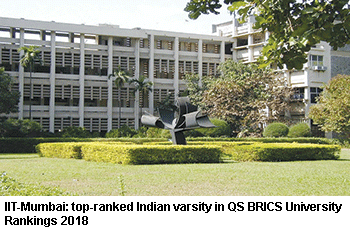 Sixty-five indian universities (higher education institutions) have made it to the Top 300 rankings of the annual QS BRICS (Brazil, Russia, India, China, South Africa) University Rankings 2018 topped by Chinese universities. Tsinghua University, Beijing, has retained its #1 ranking and a record seven Chinese universities are ranked within the Top 10.
Sixty-five indian universities (higher education institutions) have made it to the Top 300 rankings of the annual QS BRICS (Brazil, Russia, India, China, South Africa) University Rankings 2018 topped by Chinese universities. Tsinghua University, Beijing, has retained its #1 ranking and a record seven Chinese universities are ranked within the Top 10.
The latest QS BRICS Rankings 2018 were released on November 22 with the Indian Institute of Technology, Bombay (IIT-Bombay) ranked four notches higher at #9 in 2018 and one notch above the Indian Institute of Science, Bangalore, (estb.1904) as the highest-ranked ‘university’ in India. Ranked joint #179 in the QS World University Rankings (WUR), IIT-Bombay is highly ranked under 16 study programmes including Top 100 for computer science, chemical engineering, civil engineering and art & design, environmental sciences, materials sciences, and pharmacy, in the QSWUR.
Among the Top 300 BRICS universities, Delhi University is ranked #41, University of Calcutta #64, Jadavpur University #74, University of Mumbai #82 and Anna University, Chennai #85. IIT-Kanpur, IIT-Kharagpur, IIT-Roorkee, IIT-Guwahati and IIT-Hyderabad also figure among the Top 100. Among private universities, BITS Pilani is ranked #109, Manipal University #119 and Thapar University #137.
The London-based QS (Quacquarelli Symonds), one of the world’s leading higher education rating and ranking agencies, launched the annual BRICS University Rankings for BRICS countries in 2013. These separate annual league tables were developed by QS in collaboration with the Russian news agency Interfax, after it became clear that the higher education institutions of the five BRICS countries which host more than a third of the world’s population, were hopeless also-rans in the World University Rankings published by QS (and Times Higher Education) with great splash annually.
In a series of tweets, Union HRD minister Prakash Javadekar expressed satisfaction about the BRICS rankings of Indian universities. “It is no mean achievement to see 65 Indian universities being ranked in QS BRICS University Rankings 2018, which is more than Brazil (61) & South Africa (12),” he tweeted adding, “Glad that two more IITs IIT-D and IIT-M feature in Top 20. Congrats!”
Although Javadekar has expressed satisfaction with the ranking of 65 Indian universities among the QS BRICS Top 300, given that India has a long headstart over all BRICS countries in higher education — the universities of Bombay, Madras & Calcutta were established in 1857, Allahabad University in 1886 and IISc, Bangalore in 1904 — the question that needs to be asked is why are they ranked way below Chinese universities, most of whom were established after 1949 when the new communist republic was declared.
The question was implicitly answered by V.S. Chauhan, the recently appointed (April) chairman of the University Grants Commission (UGC), at a function to celebrate the QS BRICS University Rankings 2018. “We are trying to change a lot of regulations which were made long ago. In this there is space for rankings and the government is also realising that highly ranked universities are a matter of prestige for the country,” he said.
The plain fact is that over the past half century during which UGC, AICTE (All India Council for Technical Education) and MCI (Medical Council of India) were legislated as apex regulatory authorities for arts, science and commerce, engineering and technical education and medical education respectively, they have destroyed the autonomy of India’s universities and leveled down standards of higher education countrywide.
Lack of understanding as to what makes for great universities is common among regulatory authorities. Dr. Shyam Sunder, professor at the Yale School of Management of Yale University, who spoke at the celebratory event cited above, emphasised that great universities can’t be run according to civil service or business rules but require a third type of governance structure. “Great universities don’t claim finances as a matter of right. A great university ascertains what a healthy society wants it to do for it and persuades society and parents to pay for its operations. And, importantly, great universities don’t keep their finances secret,” he said.
Quite clearly India’s universities, which had a headstart over other BRICS higher ed institutions, have been slowed down by regulation and bureaucratic control, inadequate investment, poor quality of teachers and teaching, corruption, nepotism and student violence. Little wonder they have been overtaken by BRICS varsities, especially Chinese universities of new vintage. It’s a curious anomaly that China’s universities, which function under opaque communist rules and regulations, evidently enjoy generous funding and greater autonomy than India’s cabined, cribbed and confined institutions of higher education.
Autar Nehru (Delhi)